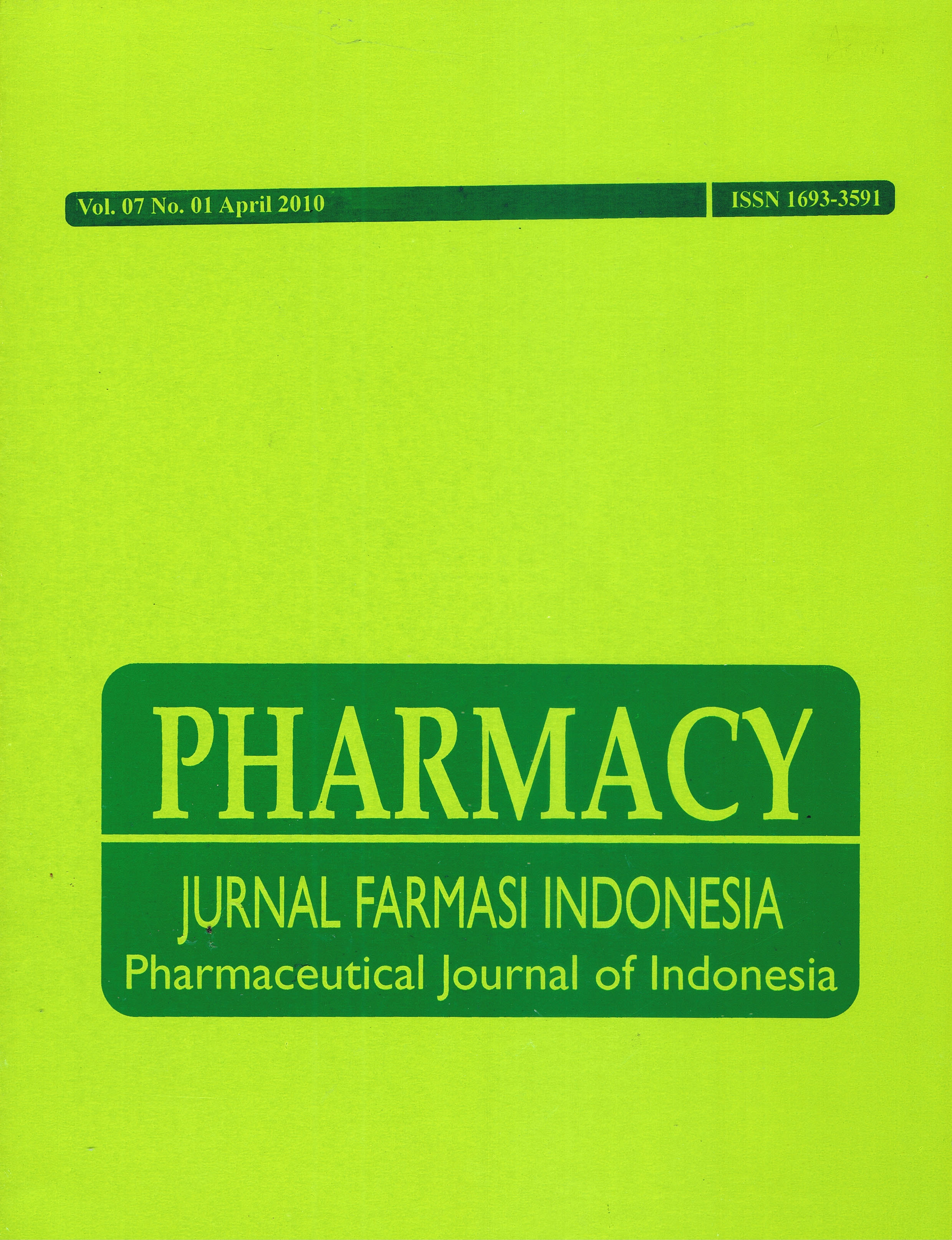ANALISIS KUANTITATIF TABLET LEVOFLOKSASIN MERK DAN GENERIK DALAM PLASMA MANUSIA SECARA IN VITRO DENGAN METODE SPEKTROFOTOMETRI ULTRAVIOLET-VISIBEL
DOI:
https://doi.org/10.30595/pji.v7i1.550Abstract
ABSTRAK Telah dilakukan penelitian validasi metode spektrofotometri Ultraviolet-Visibel (UV-Vis) untuk analisis kuantitatif tablet levofloksasin generik dan merk dalam plasma manusia secara in vitro. Tujuan dari penelitian ini adalah untuk menetapkan kadar Levofloksasin dalam plasma secara in vitro dengan metode Spektrofotometri UV-Vis dan mengetahui validasi metodenya. Validasi metode analisis meliputi linearitas, batas deteksi, batas kuantitasi, ketelitian dan kecermatan. Panjang gelombang maksimum yang digunakan adalah 295,2 nm. Hasil uji linearitas menunjukkan nilai r = 0,9936 (r hitung > r tabel = 0,878), batas deteksi (0,2256 µg/mL), batas kuantitasi (0,75 µg/mL), uji ketelitian 4,871%, kecermatan untuk penambahan levofloksasin baku 10 dan 15 µg/mL ke dalam larutan sampel merk (82,06% dan 91,47%) dan sampel generik (87,23% dan 104,88%). Hasil penetapan kadar levofloksasin dalam plasma secara in vitro diperoleh rata-rata kadar levofloksasin untuk produk generik dan bermerk berturut-turut sebesar 102,68±3,02 dan 138,53±5,82 %. Dari uji-t diperoleh hasil t hitung > t tabel yang artinya terdapat perbedaan yang signifikan antara kadar levofloksasin generik dan merk. Kata kunci: levofloksasin, validasi metode, Spektrofotometri UV-Vis, plasma, in vitro. Abstract Had been Validation of Quantitative Analysed Method of Levofloxacine Generic and Branded Tablet in plasma by In vitro with Spectrophotometry UV-Vis. The perpose of this research is determination of levofloxacine tablet in plasma by in vitro with Spectrophotometry UV-Vis and to know how this validation method. Validation of analys method such as linearity, LOD, LOQ, precision, and accuration. Beer’s law is obeyed at λ max 295.2 nm. The result of linearity assay is r = 0.9936 (r count > r tab = 0.878), limit of detection 0.22 µg/mL, limit of quantitation 0.75 µg/mL, precision 4.871%, accuration with addition of levofloxacine standard 10 and 15 µg/mL in to branded sample solution (82.06% and 91.47%) and generic (87.23% and 104.88%). Determination result of levofloxacine tablet in plasma was obtained for generic and branded products were 102.68±3.02 and 138.53±5.82 % respectively. t-test result was obtained that t count > t table, that mean there is a significan different between levofloxacin content in generic and branded. Keywords: Levofloxacine, UV-VIS Spectrophotometry, Plasma, In vitroReferences
Basset, J., Denny, R.C., Jeffrey, G.H., Mendham, J. 1994. Buku Ajar Vogel Kimia Analisis Kuantitatif Anorganik. (Terjemahan). Pudjaatmaja, A.H., Setiono. L. Edisi Keempat. Jakarta; EGC. Hlm 810.
Clevelandclinic. 2007. Blood Specimen Collection, Handling, and Transportation. http:/referencelab.clevelandclinic.org/SpecimenCollection.htm.p.3. [20 Desember 2008].
Davani MD–AA: B. dan Puderbaugh M.2008. Draft USP Pending Standard ‘Levofloxacin’. USP’s Pending Standards Guideline. http://www.usp.org. [20 desember 2008]
Harmita. 2004. Petunjuk Pelaksanaan Validasi Metode dan Cara Perhitungannya. Majalah Ilmu Kefarmasian Vol. 1, No. 3: 117-134. Jakarta: FMIPA UI
Miller, J., dan Miller, J.N. 1991.Statistika untuk Kimia Analitik (Terjemahan). Suroso. Bandung: ITB. Hlm 115-116;122.
Sundari, I. 2007. Validasi Metode Penetapan Kadar Levofloksasin Merk Dalam Plasma Secara Invivo Dengan Metode Kromatografi Cair Kinerja Tinggi. Purwokerto: Fakultas Farmasi, Universitas Muhammadiyah Purwokerto.
Downloads
Published
How to Cite
Issue
Section
License
Authors who publish with this journal agree to the following terms:
- Authors retain copyright and grant the journal right of first publication with the work simultaneously licensed under a Creative Commons Attribution 4.0 International License that allows others to share the work with an acknowledgement of the work's authorship and initial publication in this journal.
- Authors are able to enter into separate, additional contractual arrangements for the non-exclusive distribution of the journal's published version of the work (e.g., post it to an institutional repository or publish it in a book), with an acknowledgement of its initial publication in this journal.
- Authors are permitted and encouraged to post their work online (e.g., in institutional repositories or on their website) prior to and during the submission process, as it can lead to productive exchanges, as well as earlier and greater citation of published work (See The Effect of Open Access).






